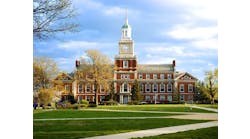The Princeton Review and the Center for Green Schools at the U.S. Green Building Council have released "Guide to 322 Green Colleges 2012 Edition," the third annual guidebook to the nation's most environmentally responsible green colleges.
The report profiles institutions of higher education in the United States and Canada that "demonstrate notable commitments to sustainability in their academic offerings, campus infrastructure, activities and career preparation."
Among the information in the guide for prospective college students:
- School profiles with application, admission, financial aid and student enrollment information.
- "Green Highlights" write-ups detailing each school's most impressive environmental and sustainability initiatives.
- "Green Facts" sidebars reporting statistics and facts on everything from the school's use of renewable energy sources, recycling and conservation programs to the availability of environmental studies programs, and green jobs career guidance.
- A glossary of 40+ green terms and acronyms
- Lists identifying schools with various green distinctions, including those with LEED-certified buildings and those that are signatories of the American College & University Presidents' Climate Commitment.
The guide stresses that the guide does not rank the institutions or provide any opinions about which schools are the greenest.
"Our aim is to highlight 322 campuses which, based on our survey of their school administrators, demonstrate a strong commitment to sustainability," the guide says. "Some of them are just in the beginning stages of defining sustainability priorities while others are reaping the rewards of a long-term commitment to green. A holistic approach to sustainable living on campus binds these schools together, covering everything from procurement and building guidelines to green academic programs and preparation for sustainable careers, and a willingness to be accountable for their green commitments."
In arriving at a green rating for each institution, the Princeton Review sought information about:
- The percentage of food expenditures that goes toward local, organic or otherwise environmentally preferable food.
- Whether the school offers programs, including free bus passes, universal access transit passes, bike sharing/renting, car sharing, carpool parking, van pooling or guaranteed rides home to encourage alternatives to single-passenger automobile use for students.
- Whether the school has a formal committee with participation from students that is devoted to advancing sustainability on campus.
- Whether new buildings are required to be certified LEED silver.
- The school’s overall waste diversion rate.
- Whether the school has an environmental studies major, minor or concentration.
- Whether the school has an environmental literacy” requirement.
- Whether the school has produced a publicly available greenhouse gas emissions inventory and adopted a climate action plan consistent with 80 percent greenhouse gas reductions by 2050 targets.
- What percentage of the school’s energy consumption, including heating/cooling and electrical, is derived from renewable sources.
- Whether the school employs a dedicated full-time (or full-time equivalent) sustainability officer.
Download the 2012 guide (PDF file, 234 pages).

